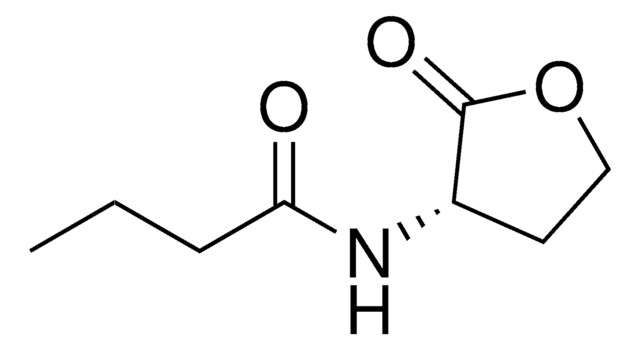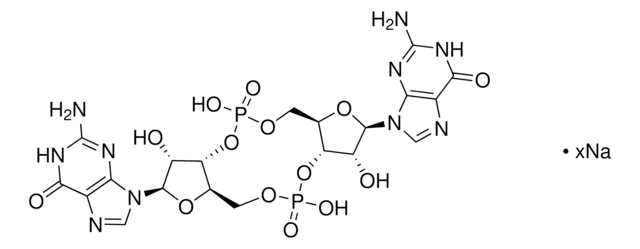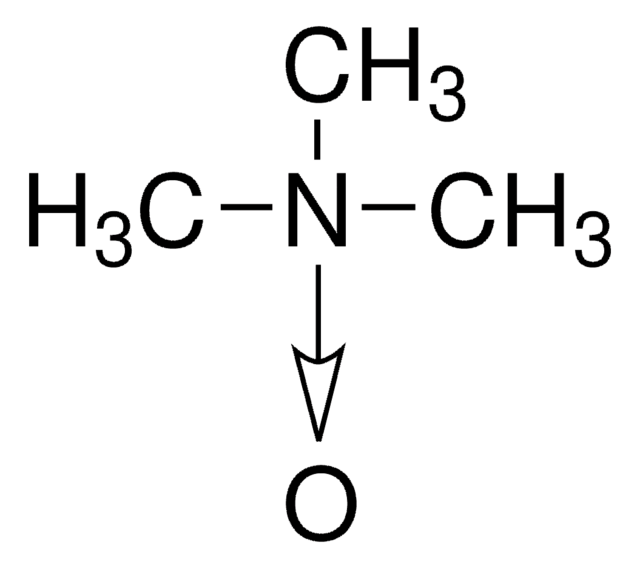42052
cis-11-Methyl-2-dodecenoic acid
≥90.0% (HPLC)
Sinónimos:
DSF, Diffusible signal factor
Iniciar sesiónpara Ver la Fijación de precios por contrato y de la organización
About This Item
Fórmula empírica (notación de Hill):
C13H24O2
Número de CAS:
Peso molecular:
212.33
MDL number:
UNSPSC Code:
12352106
PubChem Substance ID:
NACRES:
NA.25
Productos recomendados
Quality Level
assay
≥90.0% (HPLC)
storage temp.
−20°C
SMILES string
CC(C)CCCCCCC\C=C/C(O)=O
InChI
1S/C13H24O2/c1-12(2)10-8-6-4-3-5-7-9-11-13(14)15/h9,11-12H,3-8,10H2,1-2H3,(H,14,15)/b11-9-
InChI key
SNTXNGAQYNSTHI-LUAWRHEFSA-N
Application
Diffusible signal factor (cis-11-methyl-2-dodecenoic acid, DSF) is used to study cell-cell communication by pathogenic bacteria such as Xanthomonas campestris pv. Campestris (Xcc). DSF is involved in the synchronization of virulence gene expression and biofilm dispersal.
Packaging
Bottomless glass bottle. Contents are inside inserted fused cone.
signalword
Warning
hcodes
Hazard Classifications
Aquatic Chronic 2 - Eye Irrit. 2 - Skin Irrit. 2
Storage Class
10 - Combustible liquids
wgk_germany
WGK 3
flash_point_f
Not applicable
flash_point_c
Not applicable
Elija entre una de las versiones más recientes:
¿Ya tiene este producto?
Encuentre la documentación para los productos que ha comprado recientemente en la Biblioteca de documentos.
Los clientes también vieron
Heather Ohly et al.
Journal of toxicology and environmental health. Part B, Critical reviews, 19(7), 305-343 (2016-11-03)
Attention Restoration Theory (ART) suggests the ability to concentrate may be restored by exposure to natural environments. Although widely cited, it is unclear as to the quantity of empirical evidence that supports this. A systematic review regarding the impact of
Kaku Goto et al.
Oncotarget, 7(46), 74987-74999 (2016-09-08)
We recently described that the anti-apoptotic AMPK-related kinase, SNARK, promotes transforming growth factor (TGF)-β signaling in hepatocellular carcinoma (HCC) cells, as a potentially new therapeutic target. Here we explored FDA-approved drugs inhibiting the enzymatic activity of SNARK, using an in
Olubukayo-Opeyemi Oyetayo et al.
European journal of pharmaceutical sciences : official journal of the European Federation for Pharmaceutical Sciences, 97, 151-157 (2016-11-21)
Solvents used for therapeutic proteins in downstream processing and in formulations often contain stabilizing additives that inhibit denaturation and aggregation. Such additives are mostly selected based on their positive effect on thermal stability of the protein, and are often derived
Robert P Ryan et al.
Proceedings of the National Academy of Sciences of the United States of America, 107(13), 5989-5994 (2010-03-17)
RpfG is a paradigm for a class of widespread bacterial two-component regulators with a CheY-like receiver domain attached to a histidine-aspartic acid-glycine-tyrosine-proline (HD-GYP) cyclic di-GMP phosphodiesterase domain. In the plant pathogen Xanthomonas campestris pv. campestris (Xcc), a two-component system comprising
Anita Sarkar et al.
Nature communications, 9(1), 1956-1956 (2018-05-18)
Furin cleavage of the HIV envelope glycoprotein is an essential step for cell entry that enables formation of well-folded, native-like glycosylated trimers, releases constraints on the fusion peptide, and limits enzymatic processing of the N-glycan shield. Here, we show that
Nuestro equipo de científicos tiene experiencia en todas las áreas de investigación: Ciencias de la vida, Ciencia de los materiales, Síntesis química, Cromatografía, Analítica y muchas otras.
Póngase en contacto con el Servicio técnico








